






The American dancer Isadora Duncan was an extravagantly free spirit. She made noteworthy and energetic innovations in the matters of pop eugenics, interpretative dance, high-society socialism and cheerful lesbianism. Duncan, one of her very many admirers once said, was all the muses, and more besides, in a single blowsy package. She was a prototype pop celebrity. Her life was full of extraordinary achievements and strange accidents, most of them happy ones. She was, for example, scheduled to travel on the Cunard liner Lusitania’s last fatal trip from New York to Liverpool in 1915, but missed the boat and also, therefore, the torpedoes that sank it. Fate had scheduled another ending.
Throughout her life Duncan invented and maintained magnificent postures, not all of them on the stage. Indeed, it’s fair to say that she made not a great deal of distinction between the theatre and life, overacting in every venue public and private. She cultivated loopy theories: all movement, she believed, came from the solar plexus. But her expressive use of the body was not limited to the stomach area. A Communist sympathiser, once on stage in Boston she raised a red flag, exposed a breast and said: ‘This is red! So am I!’
Although there is some dispute, as there is with all the best stories, Duncan is the most often cited source for the anecdote involving playwright George Bernard Shaw. She, perhaps wearing her eugenics hat for the occasion, wrote to Shaw suggesting that sexual reproduction between them would result in a child




General George Smith Patton drove a cetacean 1938 Cadillac 75, a car with an ego as mighty as his own. It was a car that, in design terms, anticipated the gloriously absurd baroque follies of Detroit art in the fifties. It was, like its most famous passenger, big, confident, imposing and a little loud.
Some said Patton was the greatest warrior who ever lived and he had no difficulty in supplying a vivid iconography to support this ambitious claim. Though his achievements were real, including the liberation of Sicily, as head of the US Seventh Army, and rather stylishly capturing Northern France, as commander of the Third Army, his reputation was based on a camp-but-butch theatricality, as much as it was on martial expertise, a general’s vision and a soldier’s daring. He liked to pose for photographs with a helmet buffed to a non-essential shine, sporting aviator shades, jodhpurs and cavalry boots, with a trademark pair of pearl-handled Colt .45 ‘Peacemaker’ revolvers hanging from his spiffy gun belt. His army Cadillac was decorated with oversized military insignia and, lest he not be noticed in his triumphal progress through the Europe he had almost personally re-conquered, Patton liked to travel with the car’s siren wailing. Perhaps he made enemies in this fashion. Patton was known and admired for his amazing profanities. ‘No bastard ever won a war by dying for his country. He won it by making the other poor dumb bastard die for his,’ was the opening gambit to one of his celebrated speeches to the men of the Third Army; and ‘An army without profanity,’ he once said, ‘couldn’t fight its way out of a piss-soaked paper bag.’ There is a fine 1945 colour




If he were still alive, Mike Hawthorn – who won the 1958 Driver’s World Championship wearing a bow tie at the wheel of an Italian racing red Ferrari 246 – would still today be a mere eighty-eight. His image is forever the smiling, debonair, tousle-haired blond with the suggestion of a pint of bitter. Despite the Ferrari connection, you think of him as British Racing Green. Perhaps with a top-note of Brylcreem.
But he died, aged twenty-nine, in an absurd motor accident. According to police records, his British Racing Green Jaguar 3.4 Mark I – VDU 881 – had exactly 12,028 miles on the clock when he lost control on a slick Hog’s Back, the notorious blind bend on the A3 south of Guildford, a point you reach just as you escape the gravitational pull of London and approach the bosky Surrey Hills. This master of international motor sport was travelling too fast. Spinning, the car hit a bollard, bounced off a Bedford truck, and then ended its journey and his by demolishing a tree. The nearside front door impacted first and pushed the sill beyond the centre-line of the car. Engineers examining the wreck found the car was in third gear and the police estimated it had been travelling at 80mph. Just days before the crash, Hawthorn, who had never been seriously hurt in an actual race, had told a reporter: ‘The roads are getting proper death traps. The racetrack is safer than the road between London and Farnham.’
It was around midday on 22 January 1959, and Hawthorn was on his way from the Tourist Trophy Garage in Farnham to the Cumberland Hotel at Marble Arch, where he was due to have a




Mr Ever-Ready
Porfirio Rubirosa was a political fixer, a jet-set pioneer, gambler, charmer, seducer, gigolo, smuggler, racing man, mythologiser and a wonderful liar. Newspaper diarists routinely clichéd him as a ‘swarthy international playboy’. Of most interest was his sexual prowess, which became legendary, his penis achieving a celebrity of its own. By many accounts it was as large as one of the oversized pepper mills appearing in old-fashioned Italian restaurants. Several trattorias still refer to these impressive grinding machines as ‘Rubis’.
In Answered Prayers, Truman Capote’s unfinished and posthumously published novel on New York’s high life and low morals, there is the following description of Rubirosa’s membrum virile: ‘an eleven-inch café-au-lait sinker as thick as a man’s wrist’. But mere size alone did not distinguish this famous literary penis. It was also alert. Accordingly, he was known as ‘Mr Ever-Ready’, or ‘Toujours Prêt’ when at work or play in France. One slow, smoochy dance with Rubi, it was said, and any woman would recline not decline.
Rubirosa described his continuous sexual urge as le petit cochon (a little pig that started grunting at two in the morning). However, he had a nice and rather gentlemanly reluctance to discuss his penis, still less get it out in public even when fascinated voyeurs requested such a thing, as they occasionally did. Claude Terrail, owner of the legendary La Tour d’Argent restaurant, testified to Rubi’s tact and discretion. Another friend helpfully denied the inflammatory story that Rubirosa was able to balance a small table




Marc Bolan is the reason we once wore indigo nail varnish, pink feather boas, black mascara, acid-Afro perms, cheekbone glitter and very tight trousers. Maybe his influence has been exaggerated, but for a glamorous moment Bolan represented the ultimate in telegenic pop music.
Despite or because of this, no one ever thought of Bolan as a musician or a lyricist of any very great talent. But he was a pouting performer, poetaster, sex god and self-invented glamour puss of consummate genius. His twin reference points were the classic rock of Eddie Cochran and the dream world of hippy warlocks and wizards, as seen from English suburbia. Accordingly, while a prolific writer (and a published poet), Bolan’s expressive range is limited, even as it is eloquent of the abbreviated passions of his genre.
He writes (and reading it one can imagine a thumping bass playing an unheard melody): ‘Well you’re dirty and sweet/Clad in black/Don’t look back/And I love you.’ And then there was his Deb-o-ra who looked like a zeb-o-ra, whatever that means. The refrain to that song was ‘Dug a re-dug a dug a re-dug re-dug.’ ‘Da-da-da-di-di-da, da-da-da-di-di-da’ was another. That was on his 1970 breakthrough single Ride a White Swan. In a televised Pop Quest interview of 1975 Bolan says: ‘I just do what I want to do and hope it works out.’ In a lazy north London whine he also reveals: ‘I don’t like aeroplanes, you know. I don’t like travelling.’ But he did love to boogie on a Saturday night.
Anybody who has travelled from Putney towards Richmond in south-west London, along the Queen’s Ride in Barnes, knows


The author is grateful to David Morys of the Bugatti Trust, who gave access to particularly interesting, unpublished documents about Jean Bugatti.
Every effort has been made to contact copyright holders. The publishers apologise for any omissions, which they will be pleased to rectify at the earliest opportunity.
Archivio Cameraphoto Epoche/Getty Images: 152
Bettmann/CORBIS: 28, 113, 137
Derek Boshier, Courtesy of Flowers Gallery, London and New York (Private Collection): 19
British Motor Industry Heritage Trust: 90
British Motor Industry Heritage Trust/National Motor Museum: 186 Bugatti Trust: 38 www.carphoto.co.uk: 52-53
Chicago Tribune: 22 Corbis: 65
Daily Mail/Herald Hagerstown: 175
Mary Evans/Retrograph Collection: 31
Everett Collection Historical/Alamy: 48
Ford/National Motor Museum: 159
Raphael GAILLARDE/ Gamma-Rapho/Getty Images: 42
Ron Galella/WireImage/ Getty Images: 210
General Motors: 82, 135, 172-3
GIRIBALDI/GammaRapho/Getty Images: 205
GP Library/UIG/Getty Images: 97, 154-5
Granamour Weems Collection/Alamy: 180
Grant Goddard/Redferns/ Getty Images: 116
George W Hales/Getty Images: 124
Maurice Hibberd/Evening Standard/Getty Images: 189
Martha Holmes/The LIFE Picture Collection/Getty Images: 78
Kurt Hutton/Getty Images: 104
Imagno/Getty Images: 228-229
INTERFOTO/Alamy: 71
Ann Johansson: 215
Keystone/Getty Images: 176-7, cover
Keystone-France/ Gamma-Keystone/ Getty Images: 147
LAT Photographic: 62-3, 127
Earl Leaf/Michael Ochs Archive/Getty Images: 168 magiccarpics.co.uk: 194
Georges Menager/Paris Match/Getty Images: 130-1
Mirrorpix: 120
Mondadori Portfolio/Getty Images: 68
Estate Of Keith Morris/ Redferns/Getty Images: 184-5
Ralph Morse/The LIFE Picture Collection/Getty Images: 132
Spence Murray/ The Enthusiast Network/ Getty Images: 218-9
National Motor Museum: 32, 108-9, 144-5
National Motor Museum/ Heritage Images/Getty Images: 193
Omaha World Herald: 35
Pictorial Press/Alamy: 86, 202, 206
Popperfoto/Getty Images: 8-9, 94, 150, 190, 200
Sharpshooter Images / Splash/Splash News/ Corbis: 13
Studiocanal Films/ REX
Shutterstock: 165
From the collections of The Henry Ford: 119
Trinity Mirror/Mirrorpix/ Alamy: 160, 167 ullstein bild/Getty Images: 74-5, 103, 140
Roger Viollet/Getty Images: 58
Warner Bros/Getty Images: 26-7